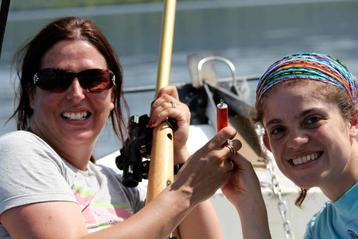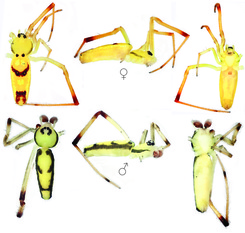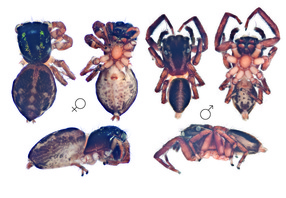Bottlenose dolphin phylogeography: Caribbean

Dr. Susana Caballero and graduate student Dalia Barragan.
Project Leaders: Dalia Barragan, Susana Caballero, Laura May-Collado
With the purpose of defining an effective conservation unit in this Archipelago of Bocas del Toro we studied the population genetics of these animals using maternal markers (mitochondrial DNA, mtDNA), and nuclear markers (11 microsatellites loci: D08, D22, TexVet5, TexVet7, MK6, MK8, MK9, EV1, Tur48, Tur91 y Tur117). We got skin samples from 13 individuals last year (2012) using a remote biopsy system (PAXARMS) (see photograph above). Results from analyses of the mtDNA control region showed that the Bocas del Toro dolphin population has a novo haplotype (unique combination of DNA sequences), shared between males and females, suggesting a high philopatry (remaining in the area of birth). The analyses clustered this haplotype in a unique clade with haplotypes of “inshore ecotype” from Cuba, Bahamas and México. This result suggests this population could be the result of a “founder effect” (the loss of geneticvariation that occurs when a new population is established by a very small number of individuals from a larger
population). Results of nuclear loci are underway and they will help us to understand the role of males in this population. These results demonstrate the vulnerability of bottlenose dolphins in Bocas del Toro, and the importance to implement strategies for a sustainable dolphin-watching activity in the Archipelago, in order to reduce boat traffic on dolphins.
With the purpose of defining an effective conservation unit in this Archipelago of Bocas del Toro we studied the population genetics of these animals using maternal markers (mitochondrial DNA, mtDNA), and nuclear markers (11 microsatellites loci: D08, D22, TexVet5, TexVet7, MK6, MK8, MK9, EV1, Tur48, Tur91 y Tur117). We got skin samples from 13 individuals last year (2012) using a remote biopsy system (PAXARMS) (see photograph above). Results from analyses of the mtDNA control region showed that the Bocas del Toro dolphin population has a novo haplotype (unique combination of DNA sequences), shared between males and females, suggesting a high philopatry (remaining in the area of birth). The analyses clustered this haplotype in a unique clade with haplotypes of “inshore ecotype” from Cuba, Bahamas and México. This result suggests this population could be the result of a “founder effect” (the loss of geneticvariation that occurs when a new population is established by a very small number of individuals from a larger
population). Results of nuclear loci are underway and they will help us to understand the role of males in this population. These results demonstrate the vulnerability of bottlenose dolphins in Bocas del Toro, and the importance to implement strategies for a sustainable dolphin-watching activity in the Archipelago, in order to reduce boat traffic on dolphins.


